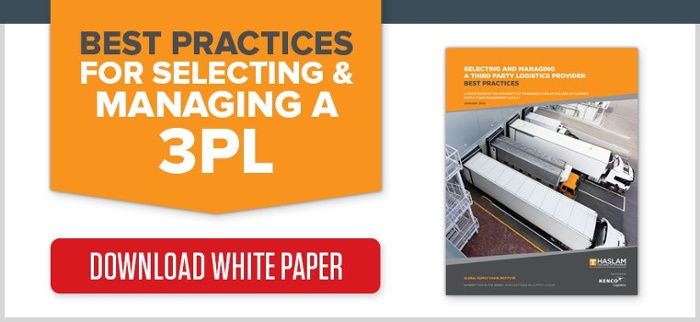The very title of supply chain indicates a wistful simplicity — a series of links all working together toward a common goal. The reality of chain operation and maintenance, however, is one any seasoned warehouse manager will confirm is far closer to herding cats than sheep.
When it comes to the constant checking and adjustment required to stay responsive and adaptable, there's no greater ally for the "boots on the ground" end-chain team than the IT department.

When it is given the proper weight and attention, IT provides a continual flow of shareable, configurable data and analytics feeds. These data points each carry paradigm-changing potential for automatic actions that keep supply and demand smoothly balanced. Echoed across an entire supply chain, those proverbial cats can nearly be taught to herd themselves.
Imagine how much more productive your supply chain managers could be if they weren't constantly "putting out fires" that could be addressed by supply chain technology solutions. Amplify that for each member of your supply chain support, and you have a company tipping point in the making.
A Little Extra Muscle
To get the most mileage out of your IT-supply chain collaboration, don't make the mistake of thinking the usefulness of information technology is relegated solely to operational concerns.
In practice, visibility isn't simply improved by the presence of robust IT assets; but rather shaped for success by the input, data-cleaning and smart modeling that IT has to offer. Consider consolidated and well-distributed data can:
- Automatically inform and/, or trigger stock reorder points.
- Populate customer-facing stock availability.
- Record fill rates and receiving speed in the warehouse.
- Emphasize what's working in your current setup, as well as what's holding you back.
- Highlight alternative routes in the event of a disruptive 3PL or supply event.
- Identify trends in the business.
This last point is a vital one; events ranging from raw material shortages to labor strikes and port closures have had devastating effects on supply chains in recent years. If you want to remain competitive and stable in your market, you must prepare for a disruption eventuality, not shrug off possibilities until it's too late.
In an article for Forbes, Steve Banker notes crisis management in the supply chain becomes infinitely easier with access to well-groomed data, courtesy of IT. Not only does this data offer you options, it clearly defines the sphere of influence, and allows you to brace for - or even offset - the ripples caused by a disruption in real time.
Strength in Data Diversification
If you are in an industry that touches on several product niches, IT has, even more, to offer in the form of segmentation. Data, after all, is not restrained to a single use and is vastly improved when passed through niche-specific filters to gain individualized insights. Industries of all sizes can benefit from these filters, such as:
- Recalls, historical data and viability tracking in pharmaceuticals.
- Label creation, proof of delivery and SKU popularity in retail.
- Raw product stock levels, supply flow data in manufacturing.
Whether finished SKUs need to be grouped and studied or raw materials need specific temperatures for storage; there's an IT solution that can streamline every step of the process.
Unfortunately, many companies fail to explore this extremely beneficial avenue, or remain "stuck" in familiar, though inefficient, ways of handling their visibility and data.
The "Don'ts" of Supply Chain Visibility
You'd be hard-pressed to find a company that hasn't chased a "silver bullet" once or twice; the lure of a cure-all for supply chain woes is an enticing one. Unfortunately, there's no silver bullet to be had — in anything, ever. Even though implementing systems like Red Prairie or SAP WM is an important step in the right direction, they're just that: a step.
You need to have a holistic outlook when it comes to your warehousing and supply chain systems if you want IT to find a harmonious fit.
This might be a harsh truth, but it's one you'll need to take to heart: execution systems just aren't suitable for supporting supply chain visibility. You need to hone your process before seizing onto tech as a solution: your IT team can only help that process if you let them! Ask for recommendations and listen to what the filtered data is telling you, or the only thing your tech will do is exacerbate the process problems already in place.
Flexibility should always be your guiding concept when building or honing your IT-supply chain connectivity; if you can't adjust your controls to your needs, or lack a dashboard that can be understood by all pertinent members of your team, all the data in the world won't matter.
The "Do's" of Supply Chain Visibility
Visibility can be expressed in silos, but it can't be confined to them: make sure your business intelligence tools allow you to see across multiple systems at the same time. Use these tools in tandem with your execution systems to form a cooperative system that will provide you with a reliable, real-time data of all systems and metrics, not just one at a time.
At Kenco, we use our own Unify to accomplish this — we find it to be an exceptionally flexible oversight system that gives us a true end-to-end picture. Visibility aside, we also make use of the system's robust dashboard - it can drill down to any particular metrics we may need to inform decisions and structure our supply chain strategies. It can also provide simple - yet highly necessary - benefits such as HR reports that we use to support our company beyond the warehouse.
Our access to near-real-time visibility performance to these metrics allows us the unprecedented ability to respond to SWOT considerations even as we keep our supply chain running smoothly.
Determining If You Need New Solutions
Before tasking your IT department with creating more solutions than you might need, ask yourself two critical questions to help narrow your collaborative focus:
- Is there a lag in our data? If there's a significant time gap between data occurring registering on your internal dashboard, that's a glaring issue that needs to be remedied. If you can't assess your data quickly, you can't act on it quickly - and that means you're just collecting numbers without real bearing on your productivity. Even a small time gap can cause these issues - any more than approximately 4-8 minutes is putting you at risk for making poorly-timed decisions.
- Are our reports generating often enough? If you're working with an outdated "legacy" style system, you're likely still working with standards that fit your needs years ago, but fall short today. Even a few short hours is enough time to lock in an alternate supplier, re-route a stalled 3PL leg or solve other time-sensitive issues that could send an unchecked disruption ripping down through your supply chain.
A Case Study in Supply Chain Visibility
At Kenco, some of our key business niches are our material handling divisions. We create asset visibility apps that connect with customer accounts as an extension of Unify - apps that work with iPads, iPhones and more, enabling technicians to use them for maintenance function guidance. These apps bring downloaded work orders to the literal palms of their hands, cutting out mistake-prone paperwork by connecting directly. These apps deliver data back to us even as they're simplifying the workflow on our "front lines" - they can tell us, for example, when a forklift in the warehouse is due for tire replacement.
This data helps us determine that a replacement will take a certain amount of hours of sourcing and implementation effort, cost a certain amount and approximately how much "life" is left in tires remaining on other warehouse equipment. This lifespan can then be programmed to auto-schedule a tire replacement, or even order the replacement tires automatically in anticipation.
Compare that to the "old" method, which would involve running a tire until it was damaged, potentially damaging the equipment and slowing down efficiency while a replacement was located.
That significant difference in methodology is the reason that your IT department - and the data they can help you collect and put to use - is so important to company growth.
To Sum It All Up
Visibility is the way of the future for the supply chain, and the sooner you learn to master it, the better your chain will endure the peaks and valleys of supply and demand. Finding a tool that offers flexibility and oversight to multiple execution systems is the no longer a fancy addition to the supply chain but a necessity.
You can ensure your 3PL has a system in place with the help of our eBook: Selecting & Managing a Third-Party Logistics Provider – Best Practices.



